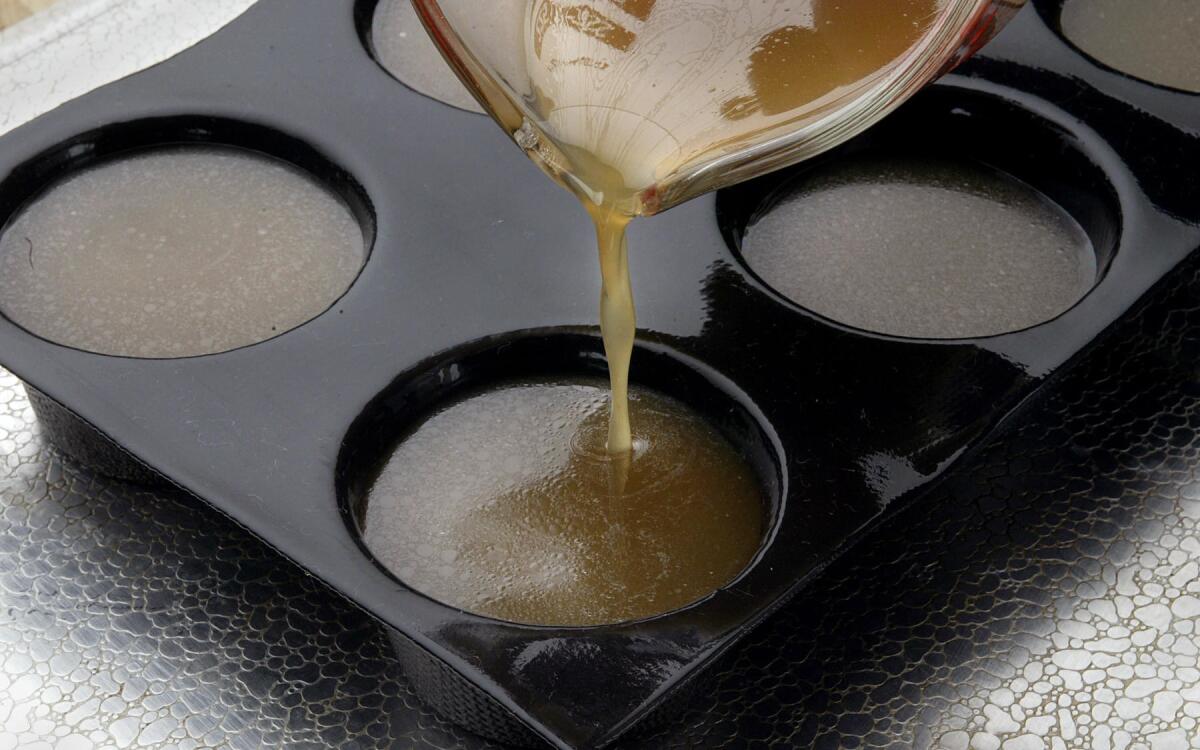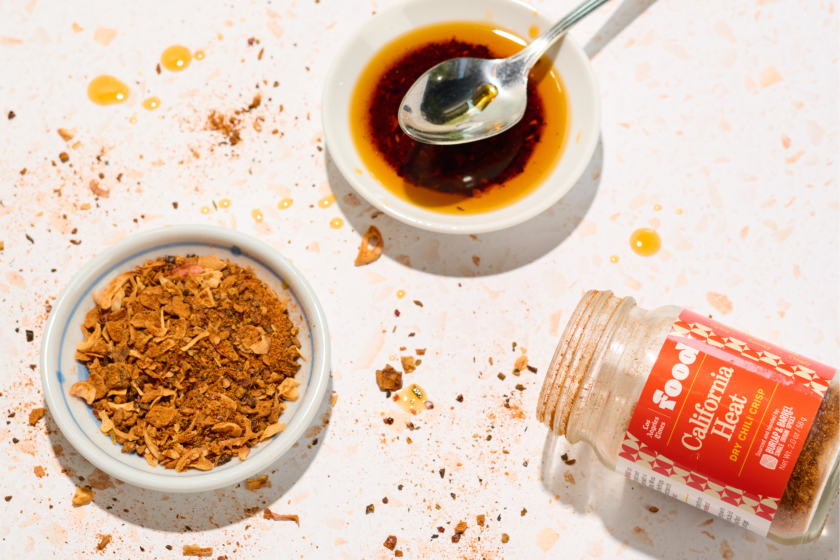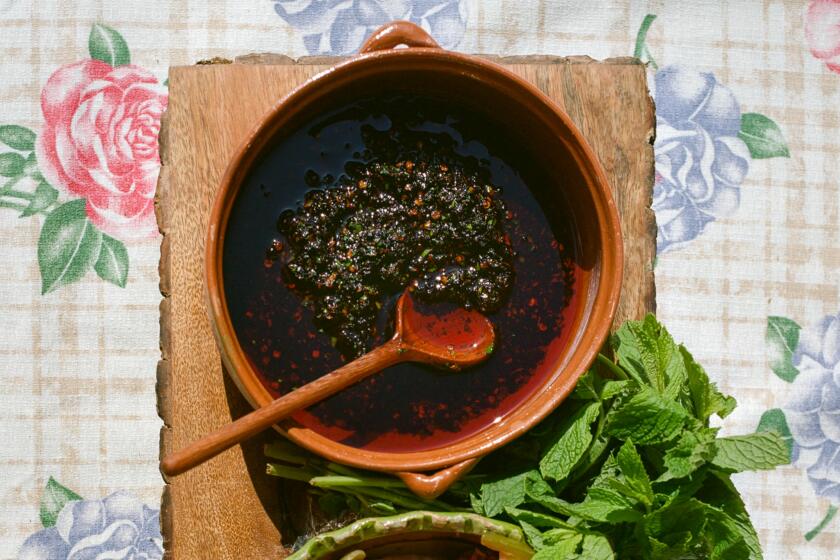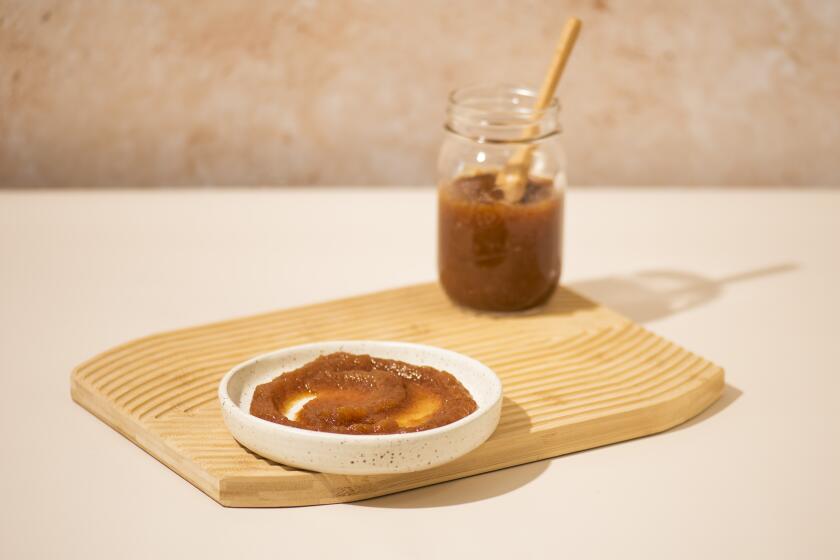Veal stock

Most weekdays, the Times Test Kitchen is a whirlwind of activity. Recipe testers, interns, writers, editors, photographers and the occasional guest chef hurry from the refrigerators to the stove tops or sinks, from the pantry to the computer desk.
Tour groups look in through a huge window from a nearby corridor to see us chopping and stirring, tasting and conferring, making notes, unloading groceries and setting up photographs.
To create, test, prepare and photograph as many recipes as we do each week, we have to be as efficient and flexible as possible.
One of the ways I do this, as Test Kitchen director, is to keep the kitchen in good working order all the time. Our annual kitchen tuneup, a sort of spring cleaning that we like to do in the early fall before the holidays hit, is our primary top-to-bottom maintenance and repair time -- and it’s a great idea for the home cook too. After all, everything we do in our kitchen, you do in yours.
In a week or so of focused effort, we test our large and small appliances (calling in service people as needed), make replacements or repairs to kitchen equipment, review and organize pantry items including spices and staples, sharpen knives, update and replace bake ware and cookware, prepare a few batches of veal stock for freezing, and take inventory of small cooking gadgets and supplies -- down to cooking parchment and twine.
Come mid-November -- when we’re brining one turkey and roasting another while at the same time experimenting with pie crusts and testing holiday cocktail recipes -- we’re glad we did.
You might want to follow something like our game plan.
Dump any ice that’s been sitting in the ice bin -- left too long, it can taste stale.
Clean out your refrigerator, tossing out the jars with a single ancient pickle or a quarter-teaspoon of mustard remaining.
Clean the shelves and crisping bins, put an open box of baking soda in the back to absorb odors, then organize the shelves in categories so all the condiments are together, jellies and jams together, etc. That way it’s easy to check ingredients at a glance when you’re making shopping lists for recipes.
Oven and stove top
Test your oven with an oven thermometer (available at hardware and grocery stores) and if the thermometer doesn’t match the setting, call a service person to calibrate it for you.
The gas company will send a service person to your home and calibrate your gas oven at no charge. They will also adjust the flame on your burners and light pilot lights that are out. Call (800) 427-2200 for an appointment.
For electric ovens, check your manufacturer’s website for authorized service representatives in your area.
Check meat and candy thermometers for accuracy too. Bring a pan of water to a boil. Check the temperature of the water: The thermometer should register 212 degrees. (For high altitude cooking, deduct 1 degree for every 500 feet above sea level.)
You can calibrate some thermometers yourself (check manufacturer’s instructions); otherwise, replace as needed.
Small appliances
Check all small electrical appliances such as food processors, mixers, blenders, and spice grinders, immersion blenders, etc. to make sure they’re working. Order any new parts, extra blades, beaters or attachments that you may need and have any necessary repairs done.
If you haven’t held on to the paperwork that came with your appliance, manufacturers’ websites such as www.cuisinart.com, www.kitchenaid.com, www.waringproducts.com or www.braun.com list customer service numbers and information about ordering parts or finding local repair shops.
Replacement parts for dozens of brands of small appliances and kitchen tools can be ordered from Culinary Parts Unlimited, (800) 543-7549, www.culinary parts.com or the Gourmet Depot, (800) 424-6783, www.the gourmetdepotco.com.
Knives
Sharp knives are the cook’s most important tool. Have your knives professionally ground once or twice a year, and remind yourself to use a butcher’s steel frequently. Meat departments at selected supermarkets are one resource for knife sharpening; otherwise take your knives to be sharpened at a cutlery or cookware shop (see sidebar).
Cutting boards
Wooden boards should be scrubbed down with salt and lemon to remove any oils and surface film that may have accumulated. Rub the cleaned boards with mineral oil (available at drugstores) or block oil (available at cookware shops). The oil conditions and seals the wood surface to prevent drying and cracking.
After oiling, rub the boards with a clean cloth to remove excess. Do not use olive oil or salad oils, which can turn rancid on your boards. Take an inventory of your plastic boards, too, and add or replace them as needed.
Cookware
While you move through the kitchen, cleaning out and organizing your shelves, look carefully at your baking pans, pie plates, tart pans, baking sheets, roasting pans and roasting racks and set aside any that should be replaced. (When you’ve prepared the perfect apple pie, you don’t want to serve it in a chipped pie plate.) Be sure that tart and springform pan bottoms aren’t missing and fit snugly.
Think about what you’ll need for the holidays. Have you put off buying a proper roasting pan? Now’s a great time to shop for one.
Pantry
Cleaning and reorganizing as you go, inventory your cupboards and drawers. Check to see that you have supplies on hand that you’re likely to need in the coming months, including kitchen twine, cheesecloth, parchment paper, aluminum foil, plastic wrap, muffin-tin liners and freezer bags. Consider adding a few such useful items as pie-crust weights.
Review your utensils. Have you invested in a good sharp vegetable peeler lately? Recent models are better and easier to use than ever. Other utensils that might need to be replaced or augmented: turkey basters, colanders, strainers, wire whisks, rubber or silicon spatulas, pot holders, cookie cutters and presses, pastry brushes and wooden spoons.
Stock
Take a test run in your newly tuned-up kitchen by making and freezing veal stock. It’s the basis for rich homemade soups, sauces and braises, and the supply you make now will come in handy dozens of times throughout the winter.
Freeze it in 8-ounce portions in freezer baggies or disposable plastic freezer containers or in ice cube trays, for those times when just a cube or two is perfect for finishing a sauce.
Heat the oven to 400 degrees. Put the cut-up bones in a single layer in a large roasting pan. Roast the bones about 2 hours. Stir the bones during the roasting process so they brown but do not burn.
During the last half-hour of cooking, add the onions, carrots and garlic.
After 2 hours, transfer the roasted bones and vegetables from the roasting pan to a large stockpot.
Pour off the fat from the roasting pan. Add enough water to cover the bottom of the roasting pan and stir to deglaze all the browned bits from the bottom of the pan. Pour the deglazing liquid over the bones in the stock pot. Add the remaining water to the stock pot.
Bring the water to a boil over medium-low heat, then reduce to a simmer and cook 2 hours. Skim the stock to remove any sediment while cooking. Skim off fat.
Add the bay leaves, thyme, peppercorns and tomatoes. Continue to simmer, loosely covered, 6 additional hours.
Strain the stock through a cheesecloth-lined strainer. Cool. Refrigerate overnight. Remove the congealed fat from the top of the stock and discard.
Warm the stock to liquid and ladle it into labeled and dated freezer bags. Lay the filled bags on a baking sheet and freeze so they can be easily stacked. Smaller portions of broth can be ladled into ice cube trays, silicone muffin pans or plastic pint cartons and frozen. Once frozen, they can be removed and put into plastic freezer bags for easy storage in the freezer.
Get our Cooking newsletter.
Your roundup of inspiring recipes and kitchen tricks.
You may occasionally receive promotional content from the Los Angeles Times.















